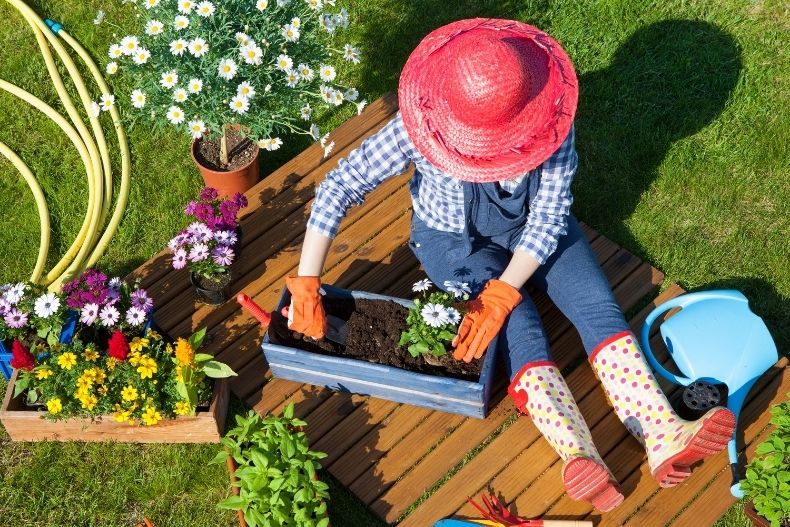Gardening can be a fantastic pastime, a way to obtain physical exercise, and even a way to beautify your house and neighborhood while also growing nutritious and healthful fruits and veggies for you and your family. Whether you are a novice or an experienced gardener, your health and safety should always come first.
Gardening or planting is a low-risk and generally safe activity, but whatever you do, some safety precautions must be taken to keep you safe, especially for individuals with health conditions like allergies or for older persons with movement difficulties like arthritis or spinal problems. Now I’m going to give you some pointers on how to garden safely.

Wear Protective Clothing
When you are ready to go to your garden to perform any work or care for your beautiful plants, you must wear protective gear to protect yourself from damage, sunburn, and injuries.
- Wear safety goggles, long pants, and sturdy shoes.
- You must wear safety gloves to protect yourself from cuts or skin irritation.
- To safeguard your hearing when using machinery to chop wood, you must wear hearing protection.
- To protect yourself from soil mites, ticks and insects, use insect repellent.
- Wear long-sleeved shirts, high rubber boots, a wide-brimmed hat, and trousers tucked into your socks.
- To avoid sunburn, use sunscreen with a sun protection factor (SPF) of 15 or higher.
- Wear a Face Mask: When spraying pesticides, whether organic or chemical, wear proper safety clothes as well as a face mask. If you don’t have a mask, at the very least wrap a hanky or towel around your nose and mouth.
Avoid Long Repetitive Movements
Repetitive actions such as digging, raking, cutting hedges, pruning shrubs, or planting bulbs may create skin, tendon, or nerve irritation unless you are acclimated to the activity. Ensure that your gardening activities are diverse and that jobs are switched every 15 minutes with a little rest in between so that the same muscles are not utilized again.
Avoid long-term continuous activities such as pruning, digging, raking, or whatever, especially for the elderly and those suffering from musculoskeletal disorders such as arthritis, tendinitis, and spine problems. You must rest regularly. Place a comfortable chair in your garden. Kneeling instead of bending your spine will put less strain on your back, according to one tip for people with arthritis and back problems. Consider wearing knee pads for added comfort. Another tip for people with wrist arthritis is to trim with a ratchet action pruner. It is specifically engineered to cut with minimum effort.
Check The Temperature
Even working for a short period in a high-temperature environment may be a major source of health concerns. So, before you head to the garden, check the temperature outside and decide how long you can stand the heat. When you go out, you should keep the following guidelines in mind:
- Try to conduct your work in the shadows.
- Drink enough water. Avoid alcohol and other beverages containing a lot of sugar or fruit juice.
- If you get symptoms such as a severe headache, dizziness, or nausea, leave the job immediately.
- Consume nutritious foods to replenish your energy.
Disease Prevention
Tetanus vaccine is critical for preventing a variety of illnesses that might occur following an injury. Every ten years, all adults should have a tetanus shot. Tetanus bacteria exist in the soil and can cause sickness when they invade our bodies. As a result, it might be dangerous for the gardener. Before establishing a garden, every gardener should get a tetanus shot. Consult your doctor.
If your garden has a lot of mosquitoes or ticks, which can cause tick bite fever, apply insect repellent lotions. As we all know, insects can transfer dengue, malaria, chickungunya, and other diseases. Consider growing mosquito and pest repellant plants in your yard as well.
Check Your Lifting
Lift big items, such as huge containers, only if you are comfortable doing so. If your abdominal wall is weak, this might result in back problems and even hernias. You may attempt this easy hack by placing heavy objects on a big cloth and dragging it along to move some heavy garden equipment.
Avoid carrying heavy things on your back: If you need to transport large objects from one location to another, you should not carry them on your back. When carrying, you can focus your legs and maintain the burden close to your torso.
Packing And Transportation of Produce
Grain quality and packaging are critical criteria for supplying safe and nutritious foods to homes at a reasonable cost. Consider fully drying these grains before packaging them. Seal the boxes or containers with shosky tamper-evident tape for security and to decrease the danger of theft.
Because proper transportation of fresh produce from farm to market helps reduce the potential for microbial contamination, it is the responsibility of everyone in the transportation chain to communicate about and take responsibility for the product’s quality and safety. Cross-contamination from other foods, nonfoods, and surfaces can occur during loading, unloading, storage, and transportation, so sanitation conditions should be evaluated wherever produce is transported and handled.
Conclusion
We hope you now have more gardening safety in your garden than you had before. As a novice or experienced gardener, the suggestions should serve to remember and sustain you while working in your garden. Your garden will be healthy and beautiful if you keep healthy and robust.











